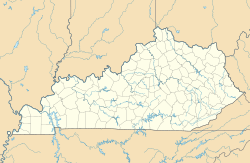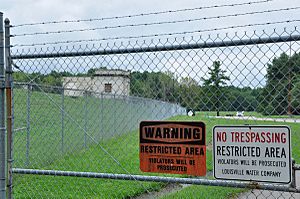Cardinal Hill Reservoir facts for kids
Quick facts for kids |
|
|
Cardinal Hill Reservoir
|
|
 |
|
| Location | Cardinal Hill Rd., Louisville, Kentucky |
|---|---|
| Area | 0 acres (0 ha) |
| Built | 1931 |
| Architectural style | Classical Revival |
| MPS | Jefferson County MRA |
| NRHP reference No. | 80001597 |
| Added to NRHP | December 5, 1980 |
The Cardinal Hill Reservoir is a special historic place located in Jefferson County, Kentucky. It's listed on the National Register of Historic Places, which means it's recognized as important to the history of the United States. This unique structure was designed by a famous architect named Victor Andre Matteson.
Contents
What is the Cardinal Hill Reservoir?
A reservoir is like a big, artificial lake used to store water. The Cardinal Hill Reservoir was built to help manage water for the area. It's not just a functional building; it's also a beautiful example of old architecture.
A Look at its History
The Cardinal Hill Reservoir was built in 1931. It was designed by Victor Andre Matteson, an architect from Chicago. His design gave the reservoir a grand and classic look. On December 5, 1980, it was officially added to the National Register of Historic Places. This honor helps protect the site for future generations.
Unique Architecture
The reservoir features a one-story building made of cut stone. It has many interesting architectural details. You can see flat, decorative columns called Doric pilasters. There's also a full entablature, which is the upper part of the building above the columns. A low wall at the edge of the roof is called a parapet wall.
The building also has decorative frames around its openings, known as shouldered architraves. The corners are decorated with special stones called quoins. The stairs leading up to the building have fancy railings, known as balustraded stairs. Along the front, there are lights set on stands, with solid structures holding lights at the corners.
Why is it Important?
The Cardinal Hill Reservoir is important because it shows the architectural styles of its time. It also represents how cities managed their water supply in the past. Being on the National Register of Historic Places means it's a valuable piece of history. It helps us understand the past and appreciate the design skills of architects like Victor Andre Matteson.




